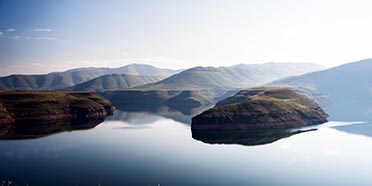
Mark is a travel writer who grew up in Africa and has written over 700 titles for Condé Nast Traveller, Travel Africa, BBC Wildlife and others.
1 person found this review helpful.
What You Lose in Wildlife You Gain (100 Times Over) in Culture
This was my first trip to Lesotho and, while I expected to like it, I didn’t expect to be so completely smitten. Even after almost a month on the road exploring most parts of this tiny country (which could fit into South Africa 40 times!) I still had a hankering to see more.
For somebody who’s drawn so much by Africa’s rich wildlife, it was a revelation – apart from some of the most spellbinding landscapes on the entire continent, it is the wonderfully hospitable and friendly Basotho people who are the main appeal. Spend time travelling in Lesotho and you will make lasting friends. Maliba Lodge (in Ts’ehlanyane National Park) is a highlight and the unforgettably appealing Malealea Lodge, nestled in a spectacular valley beyond the appropriately named Gates of Paradise mountain pass, is the sort of place where you could spend a month and still not want to leave.
I made the slow, steady 22km plod from Sani Top to the 3,482m summit of Thabana Ntlenyana. It took seven hours because, in one of Africa’s friendliest countries, we stopped frequently to converse with shepherds (kitted out in pointed hats and cloak-like blankets). We stopped to gaze up at soaring lammergeier (bearded vultures) and hunkered down in the grass to be on eye level with heartbreakingly cute ‘ice rats’.
Roads have improved incredibly over the last few years and you can spend hours cruising sweeping bends without seeing more than half a dozen vehicles. Other sections can be rough and there’s no shortage of adventure to be had with a 4x4 vehicle, tackling mountain passes and dirt-tracks where third gear constitutes a rare burst of speed.
Perhaps you’d enjoy a sense of unlimited space with pony treks – on sure-footed Basotho ponies – alongside dramatic cascades (and the highest freefall waterfall in southern Africa). Or maybe high-altitude trekking in the only country on the planet that never drops below 1,000m above sea level. If so, then you’re certainly going to be smitten by ‘the Kingdom in the Sky’ too.

Dale is a multi-award-winning writer and photographer with more than 500 published magazine articles featured in magazines such as National Geographic, BBC Wildlife, Travel Africa, and CNN Travel.
Africa’s Unexpected Winter Wonderland
With fingers and toes numbed by the cold, I survey the mountainous scene of snow and ice laid out before me, enraptured by an all-encompassing feeling of awe. It’s beautiful up here above the swirling mists and clouds atop the 3,482m Thabana Ntlenyana in Lesotho. Beautiful, empty, and wild.
I’ve been to this enclave country (which is completely surrounded by South Africa) several times over the years, and I still find it hard to believe that these frozen landscapes are in fact from the same continent as the Serengeti. It looks more like the Alps or somewhere in North America, but for the presence of Sotho sheep herders on the patchy plains far below. Clad in traditional colourful blankets, conical hats upon their heads, the young men shuffle through the snow in their trademark gum boots, whistling at their livestock who eke out a living on frosted grasses and hardy mountain heathers.
I shout and wave down to the men, who peer up, whistling a friendly greeting back at me, which echoes off the surrounding hillsides.
To my mind, there is no other place like Lesotho.
Known to many as the Kingdom in the Sky, this small 30,000km2 nation is, on average, 2,200m above sea level; the lowest point being a lofty 1,400m, and the highest at the thin-aired summit of Thabana Ntlenyana.
If you love hiking (as I do) Lesotho is the ultimate destination, with numerous routes ranging from mere hours to multiday adventures. There are also plenty of opportunities for exploring by 4x4, on a bike, or perched on the saddle of a sturdy Basuto pony.
As you amble or bounce your way along the often muddy and rocky paths and roads, you’ll be treated to the sights and sounds of a vibrant (but generally impoverished) culture in which people subsist in mountain villages of circular stone huts with grass-thatched roofs.
Wildlife is scarce and specialized to the higher altitudes, so don’t go there with the idea of finding the big five. Instead, temper your expectations and enjoy encounters with animals such as the mountain eland, baboons, and the majestic lammergeier vulture.
Highlights of this budget-friendly destination include a trip to the beautiful Sehlabathebe National Park, trekking in the amazing Maloti-Drakensberg Transfrontier Park (which forms the southern border with South Africa), and climbing the arduous and difficult peak of Thabana Ntlenyana. You can even learn to ski in the Afriski Mountain Resort.
Snow is to be expected across much of the country during the coldest months of June to August, but outside of winter, the rolling hills can alternate between being coated in golden grasses in autumn and bright green vegetation throughout the summer rains.

Ariadne is a renowned African wildlife photographer whose work is featured in many well-known guidebooks and magazines.
2 people found this review helpful.
Kingdom in the sky
The Kingdom of Lesotho is surrounded entirely by South Africa. It is nothing like its more industrialized neighbor though. When you cross the border, you feel like you go back in time. The small country is refreshingly undeveloped, and most people still live a very traditional lifestyle. What’s most striking about Lesotho is how mountainous it is. In fact, it is the only country in the world to be entirely above 1000m, hence its nickname ‘Kingdom in the sky’. Lesotho’s extreme topography makes it an ideal playground for 4x4-enthusiasts and adventure seekers. Activities include pony trekking, mountain biking, skiing (in winter), paragliding and fly-fishing. And then there is the world’s longest abseil; a thrilling 204m descent next to the spectacular Maletsunyane Falls.
There are very few roads in Lesotho and the only two national parks are best explored on foot or on horseback. This isn’t a safari destination; the main attraction is the spectacular mountain scenery. However, seeing animals on foot is always unexpected and special. I was lucky to see several herds of eland (Africa’s largest antelope), grey rhebok, jackals, Chacma baboons and lots of rock hyrax. Most endearing is the ice rat, a Lesotho near-endemic only found at high altitude.

Philip is an acclaimed travel writer and author of many guidebooks, including the Bradt guides to Uganda, Tanzania, Kenya and South Africa.
Magical mountain kingdom
Lesotho is like no other African country. Enclosed by South Africa, this small mountainous kingdom lies entirely above 1,388m (the highest national low point in the world), while 3,482m Thabana Ntlenyana, on the eastern escarpment, is Africa’s loftiest peak south of Kilimanjaro.
Few people visit Lesotho to see large wildlife. Indeed, while a network of parks and reserves supports the likes of eland, grey rhebok, baboon, rock hyrax and various small carnivores, none of the Big Five is present anywhere in Lesotho. By contrast, it is a wonderful botanical destination. Together with South Africa’s neighbouring uKhahlamba-Drakensberg Park, Lesotho forms part of a hub of ancient floral biodiversity known as the Drakensberg Alpine Centre. You’ll see a profusion of wildflowers during the rainy summer months of November to April, while autumn and winter are when the stunning red-hot pokers and aloes come into bloom.
A highlight of my visit to Lesotho was the spectacular montane scenery of golden sandstone cliffs, towering basaltic peaks and plunging waterfalls, best seen at the likes of Sehlabathebe National Park, Sani Top and Semonkong. We often drove or hiked past traditional stone-and-thatch villages, or blanketed shepherds roaming the countryside on horseback, emphasising the deep traditions that still inform Sotho society today. Other highlights include the magnificent prehistoric rock art that adorns the remote Tsatsane and Sebapala valleys, and the fortress-like sandstone plateau of Thaba Bosiu, which was the military stronghold of King Moshoeshoe I – founder of the Sotho nation – from 1824 until his death in 1870.
I was very impressed by Lesotho’s birdlife. The checklist of 350 bird species includes roughly half those whose natural range is restricted to South Africa, Lesotho and/or Swaziland (recently renamed Eswatini). We had excellent views of several of these localised specials, notably southern bald ibis, ground woodpecker, Drakensberg rockjumper, Drakensberg siskin and bush blackcap. Lesotho is the focal point for southern Africa’s last viable breeding population of the magnificent bearded vulture, and while we never saw this, we did enjoy views of several other notable birds including jackal buzzard, Cape vulture, blue crane and malachite sunbird.

Lizzie is a reputed guidebook writer and author of the Footprint guides to South Africa, Namibia, Kenya, Tanzania, Uganda and Zimbabwe.
Lesotho, the ‘Kingdom in the Sky’, a proudly independent country surrounded by South Africa
Dominated by the Maloti Mountains and a dramatic escarpment with the Drakensberg in South Africa, Lesotho’s nickname is apt – not one of its 30,355-sq-km lies below 1000-metres and many of its beautiful peaks reach above 3000-metres. In the west, a small strip of land flattens out into the Lowlands, where most of the towns are (and the majority of the population lives), including the small (and miss-able) capital of Maseru. Instead head into the highlands where mountains are spiked with stark rock, sweeping plateaus are peppered with thatched villages, herder boys and farmers on horseback roam the grassy pastures, and frothy rivers are tamed by massive dams. It’s not the easiest place to navigate, and while I’ve found driving tricky (steep passes and potholes); the rewards have been magnificent views and off-the-beaten-track adventures. Many visitors hire cars in South Africa, but tour companies from Durban or Johannesburg include Lesotho in their itineraries too.
The top things to do are hiking and trekking with sure-footed mountain Basotho ponies, both of which open up even the most remote areas that are inaccessible by vehicle. My favourite place is Malealea – a Basotho village that has a former trading-post lodge with a variety of accommodation, and a community-based tourism initiative that offers activities from pony-trekking and mountain-biking to hikes to see San rock art and traditional village visits. A similar option is Semonkong Lodge that arranges things to do including pony-trekking, hiking, abseiling, trout-fishing and rock climbing. There are also national parks and nature reserves, such as Ts’ehlanyane, Sehlabathebe and Bokong, but with altitudes of above 2000–3000-metres don’t expect to see wildlife except maybe hardy antelope like eland, mountain reedbuck and rhebok. But they are ideal for challenging hiking and you may spot birds of prey such as rock kestrels and bearded vultures.
Lesotho is a vastly underrated travel destination and the contrast with South Africa could not be more striking. It will appeal to those wanting raw adventure and natural beauty and even just a few days in its mountain lodges and trading posts will give you a fresh perspective on Southern Africa.



